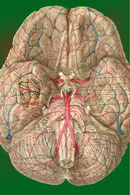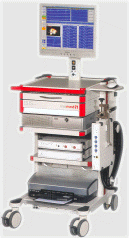|
|
|
 |
|
|
The extrapyramidal system is composed of motor fibers which do not pass through the medullary pyramids but which nevertheless exert a measure of control over bodily movements. The system is difficult to describe, partly because of the complexity of pathways and feedback loops which compose it. Nevertheless, the extrapyramidal system can be divided into three controlling systems: the cortically originating indirect pathways, the feedback loops, and the auditory-visual-vestibular descending pathways. Cortically Originating Indirect Descending Pathways At the same time signals are being transmitted over the pyramidal system to produce a specific movement, additional signals relative to the movement are also relayed to the basal nuclei, red nucleus, and brainstem reticular formation. The basal nuclei evaluate the command signal sent down the pyramidal pathways and may contribute to the establishment of needed background muscle tone for the movement. The nuclei are able to do this in part by projecting to the red nuclei, which influence spinal cord alpha and gamma motor neurons via rubrospinal tracts. Similar indirect routing to the spinal cord is achieved through corticoreticulospinal and corticorubrospinal pathways (Fig. 16-5). The function of these indirect pathways to the spinal cord motor neurons may include more than providing background muscle tone for movements directed by the motor cortex. Recall from Chap. 6 that ablation studies in which the rubrospinal tracts are experimentally cut have shown that the corticospinal and rubrospinal tracts have somewhat similar effects on spinal motor neurons. When the rubrospinal tracts of monkeys were damaged along with earlier pyramidal tract sections, the loss of skilled control in distal muscles became even more severe and yet there was little or no loss of proximal muscle control. Even so, because the red nucleus receives input from the basal and cerebellar nuclei as well as direct input from the cerebral cortex, its function may include modifying or "fine tuning" the motor neurons which innervate the muscles involved in a given movement.Feedback Loops The feedback loops described here include neural circuits in which a signal sample is fed back to a "comparator," which is in a position to compare the signal with some desired condition and subsequently take steps to "adjust" or "modify" it. The extrapyramidal system includes two such feedback systems: the cortically originating extrapyramidal system feedback loops (COEPS feedback loops) and the proprioceptor originating extrapyramidal system feedback loops (POEPS feedback loops). The CO EPS feedback loops are composed of fibers originating in the motor cortex which synapse in subcortical centers. After integrating and evaluating the signals, the centers project fibers back to the cortical source for modification. Three such loops are illustrated in Fig. 16-6. In loop A the signal is "tapped off" to the corpus striatum (caudate and putamen), which in turn project to the globus pallidus. Pallidothalamic fibers then project to the thalamus, which completes the loop by projecting back to the cortical source. Somewhere in this loop the original signal sent down the pyramidal tracts is compared and evaluated with other input relative to the movement. After appropriate integration, modifying feedback signals are returned to the cortex via the thalamocortical fibers. In loop B the sample signal is sent to pontine nuclei for subsequent referral to the cerebellum, where it is probably compared to proprioceptive input coming from muscles, tendons, and joints involved in the movement. This input probably includes such things as the current state of muscle tone and the relative position and movement of the limb involved. Following integration of this input, the cerebellum then projects its output to the thalamus (via dentatothalamic tracts) which then completes the loop by sending fibers back to the cortical source through thalamocortical projections. In loop C. the sample signal is sent to the substantia nigra. which projects in turn to the corpus striatum. From here the feedback circuit is identical to that illustrated in loop A. The importance of these feedback loops to normal motor control can be most clearly seen by an examination of the clinical signs associated with dysfunction of the basal nuclei and their related brain stem areas, which we will examine later.The other feedback loop system which is included in the extrapyramidal system is composed of the POEPS feedback loops. In this system the modification is not directed back toward the cortical source (as are the COEPS loops), but to the spinal cord motor neurons instead. The principal loop involves the relay of muscle, tendon. and joint proprioceptive information to the cerebellum via the spinocerebellar tracts. The signals are integrated in the cerebellum and probably compared with the intended signals sampled by corticopontocerebellar pathways. In this way the cerebellum might compare the intended movement with the instantaneous performance of that movement as sampled by the proprioceptors of the spinocerebellar tracts. It could then direct modification through its projections to the vestibular. reticular, and rubral nuclei and their respective descending tracts to the appropriate motor neurons of the spinal cord. Auditory Visual Vestibular Descending Pathways Postural adjustments in response to auditory, visual. and vestibular signals is an additional way to regulate the activity of spinal motor neurons. Auditory and visual input to the tectal nuclei of the midbrain may be responsible for producing reflex movements of the body in response to a sudden sound or bright light. Similarly. input from the vestibular apparatus to the vestibular nuclei and cerebellum no doubt plays a role in reflex postural adjustments through the vestibulospinal and other tracts. It should be pointed out here that because of the complex nature of the neural circuits which effect motor control through routes other than the pyramidal system, a precise and universally agreed upon definition of the extrapyramidal pathways has never been achieved.Clinical Signs of Basal Nuclei and Related Brainstem Dysfunction
Certain disease conditions relating to motor control appear to be positively linked to dysfunction of the basal nuclei and those structures functionally related to them including the thalamus, subthalamus, and substantia nigra. Chorea is a condition characterized by uncontrolled random movements of the body often accompanied by facial grimaces. Evidence indicates that the condition is often associated with dysfunction of the corpus striatum. It is often seen as a complication of rheumatic fever in children. Recovery from this childhood form of the disease, Sydenham's chorea, is usually complete with no subsequent lingering effects. A more severe form, Huntington's chorea, is a hereditary disease which becomes progressively worse and often leads to severe mental debilitation. A thetosis is a condition characterized by slow wormlike movements of the peripheral appendages, and is also associated with damage to the corpus striatum and lateral parts of the globus pallidus. Voluntary movements in the affected appendages are often impaired. Violent flinging of a limb or limbs is a rare condition called ballismus. If one limb is involved the condition is called monoballismus, and if both limbs on a single side are affected the term is hemiballismus. It is generally associated with damage to the subthalamus and can occur spontaneously or be brought on by the initiation of a voluntary movement involving the affected limb. Perhaps the most familiar disease condition in this group is Parkinson's disease (paralysis agitans). It is characterized by an increasing tremor during rest. Also observed are a "pill-rolling" action of the fingers, a poverty of movement expressed by difficulty in initiating voluntary movements such as getting up from a chair and walking, a plastic or deathlike rigidity often demonstrated by a "cog-wheeling" phenomenon when a limb is passively moved, and an increasing masklike fixed expression to the face. The cog-wheeling phenomenon that occurs as a limb is passively moved is tentatively explained by the following mechanism. Initial resistance is due to muscle tone as the limb is moved. Release comes when group Ib afferents from Golgi tendon organs inhibit homonymous alpha motor neurons. Then as the passive movement of the limb continues, tension again develops until the threshold of the Golgi tendon organs is once again reached, causing a second release. This rachetlike movement continues as the limb is passively moved. Parkinson's disease is usually associated with dysfunction of the basal nuclei and the substantia nigra.Feedback loops in electronic systems must be finely tuned in order to prevent oscillations. In physiological systems the feedback loops must also be working properly in order to prevent oscillations in muscle systems. In Parkinson's disease, the fine tuning is lost and oscillating signals to motor neurons produce tremors. It appears that the principal, site of malfunction lies in the dopamine-releasing fibers of the nigrostriatal pathway. There are both excitatory cholinergic nigrostriatal fibers and inhibitory doparninergic nigrostriatal fibers. Fine tuning seems to require the complete integrity of both types. In Parkinson's disease, the feedback system becomes "untuned" by the inability of the inhibitory dopaminergic neurons to produce and release dopamine. Some success has been achieved in the treatment of this condition by the adminstration of i.-dopa, a dopamine precursor which is taken up by dopaminergic nigrostriatal fibers and converted to dopamine. With this subsequent "replacement" of the missing transmitter, some degree of fine tuning is restored and the severity of symptoms is often reduced
|
|
|
Copyright [2007] [CNS Clinic-Jordan]. All rights reserved


